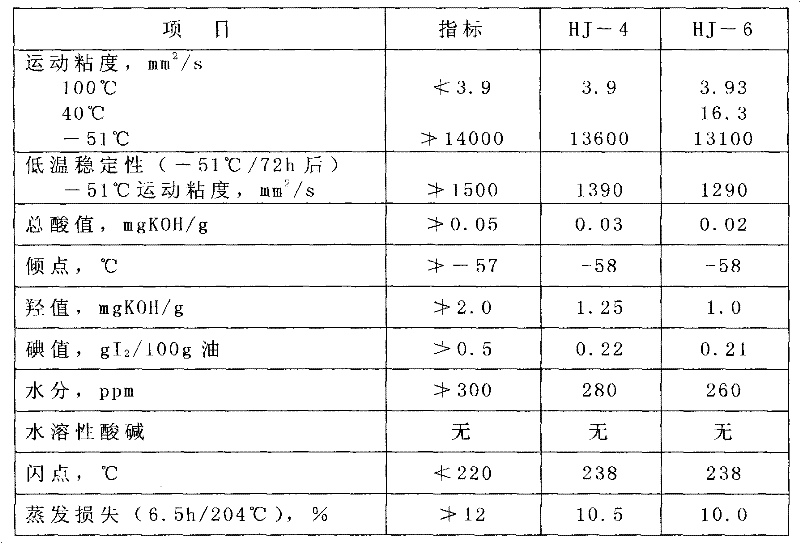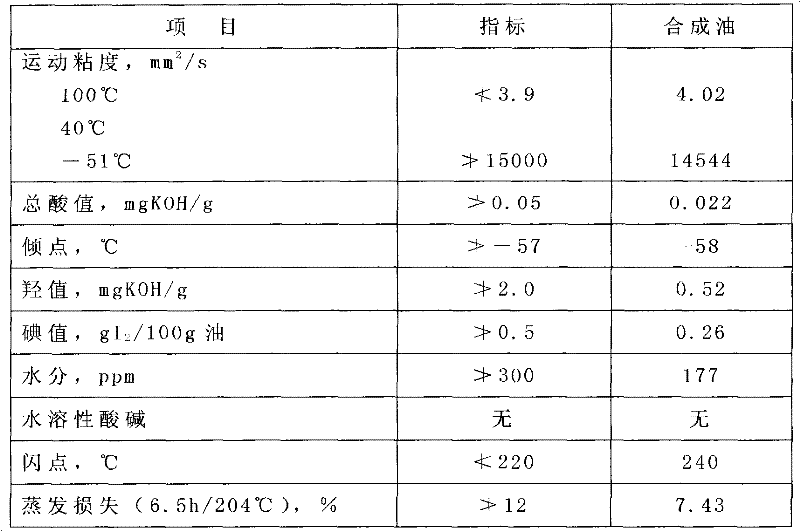A new type of aviation base oil
A base oil and aviation technology, applied in the field of aviation lubricating oil, can solve problems such as poor low-temperature pumpability and start-up performance, insufficient high-temperature performance and stability, and poor low-temperature performance, so as to improve service performance and stability, Effects of improving stability and safety and increasing productivity
- Summary
- Abstract
- Description
- Claims
- Application Information
AI Technical Summary
Problems solved by technology
Method used
Image
Examples
Embodiment 1
[0037] ①Raw material specification
[0038] N-valeric acid content ≥ 99.0% Color ≤ 30 black Zeng Iodine value 2 / 100g,
[0039] N-hexanoic acid content ≥ 99.0%, color ≤ 30 black Zeng, iodine value 2 / 100g,
[0040] N-heptanoic acid content ≥ 99.0% Color ≤ 30 black Zeng Iodine value 2 / 100g,
[0041] Nonanoic acid content ≥ 99.0% color ≤ 30 black Zeng iodine value 2 / 100g,
[0042] Pentaerythritol content ≥ 98.0%,
[0043] Trimethylol dioxane content ≥ 99.0%,
[0044] Activated carbon decolorization power ≥ 12;
[0045] ② Formula
[0046] Phase I Raw Materials
[0047] 143 kg of n-valeric acid, 36 kg of isovaleric acid, 81 kg of n-hexanoic acid, 409 kg of n-heptanoic acid, 51 kg of isooctanoic acid, 167 kg of n-nonanoic acid, 91 kg of pentaerythritol, 191 kg of trimethylolpropane, 12 kg of activated carbon ;
[0048] Phase II Raw Materials
[0049] 114 kg of n-valeric acid, 28 kg of isovaleric acid, 65 kg of n-hexanoic acid, 328 kg of n-heptanoic acid, 40 kg of isoocta...
Embodiment 2
[0054] Raw material is as described in the table below, and all the other are with embodiment 1.
[0055] raw material
Phase 1 (kg)
Phase II (kg)
n-valeric acid
143
114
Isovaleric acid
36
28
81
65
n-heptanoic acid
409
328
isooctanoic acid
51
40
167
133
91
191
12
[0056] The deacidification reaction in this example is carried out with reference to the method and equipment provided in "Research on Deacidification of High-acid Crude Oil by Heat Treatment" published by Shen Haiping and others in "Petroleum Refining and Chemical Industry" Volume 35 No. 2 in February 2004 operation.
[0057] The resulting product properties:
[0058]
[0059] Odd-numbered fatty acids in ester oils have lower pour point and pour point. ...
Embodiment 3-17
[0061] The preparation method is the same as in Example 1, and the detailed raw material ratio is shown in the table below, and the numbers of Examples 3-17 are ABCD...I-3.
[0062]
[0063]
[0064]
[0065]
[0066] The performance of the product of the present invention will be further described below by taking the detection data of Example 1 of the present invention as an example.
[0067] Table I: Consistency check of Embodiment 1 of the present invention.
[0068]
[0069] Table II physical and chemical and performance requirements.
[0070]
[0071] Note:
[0072] 1 was titrated to an endpoint of pH 11.
[0073] 2 Not more than 6% compared with the result measured in 35 minutes.
[0074] 3 The test time is 6.5 hours, and the bath temperature is 205±1°C. Using ASTM E1-67 No. 80-F thermometer, the air temperature is maintained at 205 ± 1 °C and preheated if necessary.
[0075] 4mg / in 2 Multiply by 1.55 to convert to g / m 2 .
[0076] 5 In order to...
PUM
 Login to View More
Login to View More Abstract
Description
Claims
Application Information
 Login to View More
Login to View More - R&D
- Intellectual Property
- Life Sciences
- Materials
- Tech Scout
- Unparalleled Data Quality
- Higher Quality Content
- 60% Fewer Hallucinations
Browse by: Latest US Patents, China's latest patents, Technical Efficacy Thesaurus, Application Domain, Technology Topic, Popular Technical Reports.
© 2025 PatSnap. All rights reserved.Legal|Privacy policy|Modern Slavery Act Transparency Statement|Sitemap|About US| Contact US: help@patsnap.com



